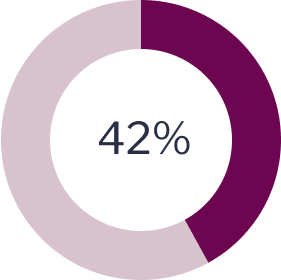See how our services
make an impact.
2024 Tech Trends
We expect technology to evolve and change at a rapid pace, but with emerging technologies like AI (Artificial Intelligence), AR (Augmented Reality), Machine Learning, and other next-generation technologies entering the forefront of technological advancement, it can feel hard to get ahead and stay ahead of the ever increasing digital curve. Ongoing technological advancement can lead to an “evolve or parish” reality for firms that aren’t adopting as fast as their competitors. By purposefully focusing on a few key trending technologies that relate to your specific business/industry, your digital organization can stay ahead of the curve. At Tonic, our teams are well versed in emerging technology trends, and can help you keep your finger on the pulse of what will be sure to be buzzing in the industry this year.
Trend 1: Rise of Spatial Computing

First we had the personal computer in the 80s, the internet in the 90s, iPods in the 2000s, smartphones in the 2010s. Spatial computing is going to define the 2020s, according to Tonic’s Mobile Lead, Dusty Fields. “Spatial computing is an evolving form of computing that blends our physical world and virtual experiences using a wide range of technologies, thus enabling humans to interact and communicate in new ways with each other.” (Harvard Business Review) And this trend isn’t just confined to AR/VR headsets. With the maturity and usage of voice assistants and gesture based computing gaining traction, tasks normally done on a traditional computer can now be accomplished in different ways on different devices utilizing users’ senses.
Spatial computing is an evolving form of computing that blends our physical world and virtual experiences using a wide range of technologies, thus enabling humans to interact and communicate in new ways with each other.
Harvard Business Review
Further, Fields points out “there will be major overlaps between Spatial Computing, AI (Artificial Intelligence), and ML (Machine Learning). This will change both engineering and design roles as we'll have to start thinking even more than just screens. We'll have to start thinking about the space around us, the environment, accessibility with gestures/voice/etc.”
Trend 2: Evolution of Generative AI

While users became more and more comfortable with AI in 2023, 2024 will be the year of Generative AI used to solve people’s problems rather than simply provide answers. “Generative AI is using large language models to stage intelligent, two-way conversations, giving people solutions to “I want to” rather than simply “I want a.””
People between the ages of 18 –34 on conversational AI

39% of people aged 18-34 are excited about conversational answers over standard internet searches.
source: Accenture

42% are comfortable using conversational AI to find product recommendations.
source: Accenture
This evolution will reframe user’s intentions when turning to AI from search behavior types, to conversational. “39% of people aged 18-34 are excited about conversational answers over standard internet searches.” and “42% are comfortable using conversational AI to find product recommendations.” (Accenture) We expect these percentages to grow exponentially over the next year. Businesses will need to re-evaluate their methodology in providing answers to users to better fit with this mindset shift.
Trend 3: Focus on Sustainable Technology

For years, there’s been a division between tech and physical sustainability. 2024 will be the year that sustainability efforts focus on tech. Gartner predicts that by 2027, 25 percent of chief information officer compensation will be linked to sustainable technology impact. The company also predicts that by 2027, 80% of CIOs will have performance metrics tied to the sustainability of their IT departments. This investment by business shows alignment between cultural expectations and leadership KPIs.

By 2027 80% of CIOs will have performance metrics tied to the sustainability of their IT departments
source: Gartner
What does this mean for consumers? Renewable energy is predicted to rise to 35% (of energy sources) by 2030 as the technologies for wind, hydro, and solar continue to improve and become more accessible. The trend toward remote work and digitizing business practices will also help reduce the environmental impacts businesses have. In the coming years, the Green Business Bureau also predicts that IoT (Internet of Things) will help businesses reduce their carbon footprint by better analyzing their energy consumption. (Gartner) Even big tech companies like Apple are now making products carbon neutral from end-to-end even offsetting the carbon footprint by how much a user utilizes their device. Users of the Apple Home App might notice a little tracker that tells them when they are consuming green energy in their location. Users are becoming more mindful about both the purchasing and usage decisions.
Trend 4: Consumers Desire Connection to Solve Problems

With the evolution of new technological approaches to providing customer support, the human-touch of providing customer support is less than ever. AI, especially generative AI, is helping propel CX potential forward at a rate that’s not been seen before. However, not all consumers like this change. “47% of customers feel less valued when they face difficulty reaching or talking to unsupportive customer service agents.” A lack of human touch is causing customers to feel devalued. It’s not just technological advancements that are leading to this sentiment. “Organizations have long held customers’ needs at the heart of every decision, knowing that good customer experience led to healthy revenue growth. This is still the case, but economic challenges are forcing compromises, hitting customers’ pockets.” (Accenture) There’s value in cutting overhead costs through adopting technological solutions when it comes to customer service, but there are also costs associated with doing so.
We’re also seeing that digital channels lead to lessened satisfaction when compared to their human counterparts. “Lower preference for digital channels revealed in the data is largely influenced by consumer expectations on the quality of those interactions. As organizations improve the accuracy and effectiveness of the digital experience, we should expect consumer appetite to also rise.”Experts are finding that “Customers love the ease and convenience of digital, right up until they hit a problem, then frustration builds quickly.” (Qualtrics) To help remedy these frustrations, organizations should allow customers to easily switch between CX methods to better suit their needs and place within their own consumer journey. This flexibility should lead to increased customer satisfaction, and therefore lead to increased customer loyalty and retention.
Trend 5: Solutions in the Way of Responsible Tech

Advancement in technology certainly has its benefits. But how does society react when technological advancements go awry or are used for less than well-intentioned scenarios? Societal issues like social media addiction, fake news, non-identified AI generated content, and deep fakes are emerging issues within the space. However, tech firms have also been ones to spearhead solutions. X (formerly Twitter)’s solution to inaccurate tweets comes in the form of community notes - a vetted community to fact check tweets, similar to Wikipedia. Applications like AntiSocial, Flipd, and OneSec are all solutions created to curb social media addiction.
with the introduction of AI comes the need to regulate and use it responsibly.
Square
Further, “with the introduction of AI comes the need to regulate and use it responsibly. As AI enters more spaces, both personal and professional, discussions around how to create responsible AI and use it will enter board rooms and living rooms alike.” (Square) While some responsibility might continue to rely on human-touchpoints, such as teacher identification of student tone or proper citation of work, there is a possibility to program AI generation to recognize plagiarism and IP (Intellectual Property).
Trend 6: Recognition of Deepfakes

2024 is going to be an election year. 2024 will also be the year that deepfakes will present to be a persistent problem. There have already been advertisements created with fake images generated by AI in previous election cycles, however deepfakes will prove to be even more problematic. Deepfakes are images, or more often videos, created with a type of machine learning called deep learning that resembles the examples it’s been given. These can look like a number of different formats, but frequently feature a compelling video of a recognizable figure saying something that they’ve never actually said before. This can be exceptionally problematic, as they are more difficult for the general public to identify as fake than previous iterations (photoshop, face swap, etc.).
The promising news is that technologies are emerging to help recognize and combat deepfakes. Blockchain could be a potential solution to combating the issue of harmful deepfakes. According to the World Economic Forum,“blockchain’s ability to provide decentralized validation of authenticity and a clear chain of custody makes it potentially effective as a tool to track and verify not just financial resources, but all sorts of forms of content.but the problem is how to get that to everyday users.” (WEForum) Additional possible solutions could include the marrying of physical and technical in the form of IOT verification or deepfake detection utilizing AI. Due to the likely prevalent nature of deepfakes in an election year, we foresee the advancement of technology combating them to accelerate quickly within the next few months.
Trend 7: Increase of Automation

Not to be confused with AI, ML, or other types of automation technologies - in 2024 we’ll see the continued rise of automation spread through to the everyday. Given that distinction, what is automation, anyway? “Some people lump AI and automations together, but automations tend to be a bit more rigid. They typically work by following a set of rules to complete a task rather than requiring an input and running an algorithm against varying conditions to come up with a result the way AI does.” Automation already has various applications in the real-world - from data entry to garage opening applications (like our client, Parkade) to automated doggy doors. We expect in 2024 and into 2025 we’ll begin to see a noticeable shift to automation within the workplace.
Though it may sound intimidating, “automations have the power to streamline work and reduce redundant tasks to help free up time. They can be used for marketing, customer relations, time management, personalization, and so much more.” (Inc) We anticipate that while automation may replace some office / tech jobs it also has a probable outcome of creating new jobs while forcing people to learn new skills and diversifying their resumes. Making the overall outcome positive in creating a more marketable and resilient workforce.

Get in Touch
We'd love to see how we can make an impact for you. Let us know what you're working on.


